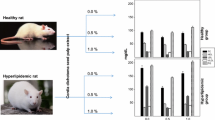Abstract
The effect of the administration of coriander seeds (Coriandrum sativum) on the metabolism of lipids was studied in rats fed a high fat diet with added cholesterol. The spice had a significant hypolipidemic action. The levels of total cholesterol and triglycerides decreased significantly in the tissues of the animals of the experimental group which received coriander seeds. Significant increases in β-hydroxy, β-methyl glutaryl CoA reductase and plasma lecithin cholesterol acyl transferase activity were noted in the experimental group. The level of LDL + VLDL cholesterol decreased while that of HDL cholesterol increased in the experimental group compared to the control group. The increased activity of plasma LCAT, enhanced hepatic bile acid synthesis and the increased degradation of cholesterol to fecal bile acids and neutral sterols appeared to account for its hypocholesterolemic effect.
Similar content being viewed by others
References
Sharma RD, Raghuram TC (1991). Hypolipidemic effect of fenugreek seeds: A clinical study. Phyt Ther Res 30: 145-147.
Kamanna VS, Chandrasekhara N (1992). Effect of garlic on serum lipoproteins and lipoprotein cholesterol levels in albino rats rendered hypercholesteremic by feeding cholesterol. Lipids 17: 483-488.
Gujaral S, Bhumra N, Swaroop M (1978). Effect of ginger oleoresin on serum and hepatic cholesterol levels in cholesterol fed rats. Nutr Rep Int 17: 183.
Sambaiah K, Satyanarayana MN (1982). Influence of red pepper and capsaicin on body composition and lipogenesis in rats. J Bio Sci 4: 425.
Subbarao D, Chandrasekhara N, Satyanarayana MN, Srinivasan M (1970). Effect of curcumin on serum and liver cholesterol levels in cholesterol fed rats. J Nutr 100: 1307.
Menon PV, Kurup PA (1976). Dietary fiber and cholesterol metabolism: Effect of fiber rich polysaccharide from black gram (Phaseolus mungo) on cholesterol metabolism in rats fed normal and atherogenic diet. Biomedicine 24: 248.
Abell LL, Levy BB, Bordie BB, Kendall FE (1952). A simplified method for the estimation of total cholesterol in serum and demonstration of its specificity. J Biol Chem 195: 357.
Abraham A, Kurup PA (1988). Mechanism of hypercholesterolemia produced by biotin deficiency. J Bio Sci 12: 187.
Okishio T, Nair PP, Gordon M (1967). Studies on bile acids: The micro quantitative separation of cellular bile acids by gas-liquid chromatography. Biochem J 102: 654.
Grundy SM, Ahrens EH, Miettinen TA (1965). Quantitative isolation and gas-liquid chromatographic analysis of total dietary and neutral sterols. J Lipid Res 6: 411.
Robert H Palmer (1969). The enzymatic assay of bile acids and related 3 hydroxy steroids: It application to serum and other biological fluids. Methods in Enzymol 15: 280.
Ghanbari Sissan MA, Leelamma S (1996). Influence of components of oral contraceptive on lipid metabolism. Indian J Exp Biology 34: 131-134.
Warnick GR, Albers JJ (1978). A comprehensive evaluation of the heparin-manganese precipitation procedure for estimating high density lipoprotein cholesterol. J Lipid Res 19: 65.
Venugopalan Rao A, Ramakrishnan S (1975). Indirect assessment of hydroxymethyl glutaryl CoA reductase (NAOPH) activity in liver tissue. Clin Chem 21: 1523.
Annie A, Kurup PA (1986). Dietary carbohydrates and regulation of the activity of HMGCoA reductase and cholesterol metabolism. Indian J Biochem Biophys 23: 28.
Lowry OM, Rosebrough NJ, Farr AL, Randal RJ (1951). Protein measurement with the Folin phenol reagent. J Biol Chem 193: 265.
Bennet CA, Franklin NL (1967). Statistical analysis in chemistry and the chemical industry. New York: John Wiley and Sons.
Sharma RD, Raghuram RC, Sudhakar Rao N (1990). Effect of fenugreek seeds on blood glucose and serum lipids in Type I diabetes. Eur J Clin Nutr 44: 301-306.
Srinivasan K, Sambaiah K (1991). The effect of spices on cholesterol 7 alpha-hydroxylase activity and on serum and hepatic cholesterol levels in the rats. Int J Vit & Nutr Res 61(4):364–369.
Hume CW (1972) The UFAW Handbook on the care and management of laboratory animals. Edinburgh/London: Churchill Livingstone.
Author information
Authors and Affiliations
Rights and permissions
About this article
Cite this article
Chithra, V., Leelamma, S. Hypolipidemic effect of coriander seeds (Coriandrum sativum): mechanism of action. Plant Foods Hum Nutr 51, 167–172 (1997). https://doi.org/10.1023/A:1007975430328
Issue Date:
DOI: https://doi.org/10.1023/A:1007975430328




